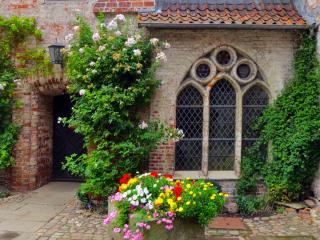

What is a courtyard? Might seem like a basic question, but it’s often important to clarify what we’re talking about in order to get things right. According to the dictionary, a courtyard is “ an open-air space surrounded with walls and/or buildings, belonging to a household or community building ”. So setting up a courtyard with lots of shade means caring for an enclosed space, usually rather small, which only gets very little light.
It seems like all these limitations would make such a feat impossible, doesn’t it? Worry not! Thanks to our tips, you’ll find it quite easy to turn your courtyard into a great place to hang out.
<!– silent
Read also:
–>
The first tip to help you organize a shade-covered courtyard is to consider it exactly as you would an actual room in the house. With that notion as a starting point, simply follow basic indoor house design rules to visually transform the space provided by your courtyard. Choosing the right colors and selecting which walls to paint make a huge difference in how big you feel the “room” is. It can make the space feel wider, larger, or deeper. Here is a quick summary to help understand and choose your colors:
This will certainly be one of your goals: make your court seem larger than it really is. Typically, you’d make more use of cool colors (blue, green, etc.), and they’d also be lighter, such as pastel hues. You don’t necessarily need to paint. It’s perfectly possible to screw wooden trellises onto the wall, and tether climbing vines to them: ivy, honeysuckle, climbing hydrangea, etc.
Now, if you’re aiming to visually widen your courtyard, similar principals apply. Create contrast, with the back wall being the darkest and side walls coming out much lighter.
Conversely, a lighter back wall together with darker side walls will provide more depth to your courtyard, a nice optical illusion as well.
Do you like cocooning and would really like to feel that sensation outdoors? In that case, go for ivory or light tan colors, and just paint two touching walls (left and back, or back and right). This will result in a nice intimate atmosphere.
Depending on how you intend to use your courtyard, you’ll need different layouts and materials for the ground:
 If you simply want to lay back in a reclining garden chair, no need for stability: any ground cover will do. Fans of gravel will thus set up hollow core slabs on the ground, and fill them up with gravel. Having the gravel locked in the honeycomb structure makes walking easier.
If you simply want to lay back in a reclining garden chair, no need for stability: any ground cover will do. Fans of gravel will thus set up hollow core slabs on the ground, and fill them up with gravel. Having the gravel locked in the honeycomb structure makes walking easier. Selecting the right plants may seem a hurdle, because they definitely need to be shade plants. However, you’ll soon find out that there is a wide selection of plants that prefer shade to sun! For instance, here are a few quick picks:
Selecting the right plants may seem a hurdle, because they definitely need to be shade plants. However, you’ll soon find out that there is a wide selection of plants that prefer shade to sun! For instance, here are a few quick picks:
After you’ve made your pick comes the time to finally plant. In most cases, your courtyard is cemented all over. You’ll have to go for garden boxes (wooden ones, or resin ones), pots (plastic, clay, resin), raised beds, etc. This is actually an advantage, since you can now customize the soil mix in each box to the plants that go in it. For instance, you’ll put more peat for heath plants than in other boxes.
 Another advantage is that you can use the boxes and pots themselves to add color to your courtyard. Mix shapes, colors and sizes as you choose your containers, it’ll make your courtyard feel very lively! If, on the other hand, the courtyard still connects to the earth below, you can amend the soil and create magnificent growing beds with flowered borders along the edges.
Another advantage is that you can use the boxes and pots themselves to add color to your courtyard. Mix shapes, colors and sizes as you choose your containers, it’ll make your courtyard feel very lively! If, on the other hand, the courtyard still connects to the earth below, you can amend the soil and create magnificent growing beds with flowered borders along the edges.
 Select these with care, with one target in mind: counter the darkness and break that sensation of feeling cramped in courtyards that are often rather small. To that end, here are a few ideas:
Select these with care, with one target in mind: counter the darkness and break that sensation of feeling cramped in courtyards that are often rather small. To that end, here are a few ideas:
Congratulations! You now are a master at landscaping a shade-covered courtyard! Let your imagination run wild and set up your dream courtyard right away.
<!– silent
–>